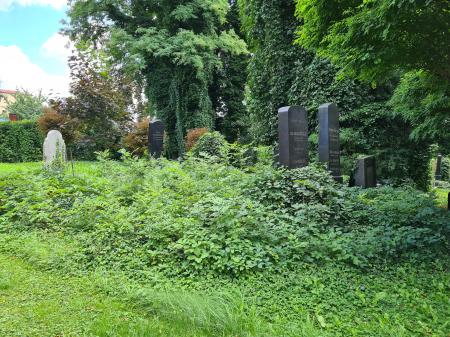Obj. ID: 51951
Jewish Funerary Art Jewish cemetery in Bielsko Biała (Bielsko), Poland

According to ESJF European Jewish Cemeteries Initiative, until the middle of the 19th century, Jews from Bielsko were buried in the cemetery in Cieszyn. The cholera epidemic and the ban on transporting dead bodies issued in 1849 enabled the community to build its own cemetery, which was located in the Aleksandrowice district. In 1868, the Chevra Kadisha (burial society) was established to maintain the cemetery. In 1885, a funeral house in the neo-Romanesque-Moorish style with unique polychromes on the ceilings, designed by Karol Korn, was built in the southern part of the cemetery. The oldest discovered tombstone is dated September 3, 1849, although it is known that funerals took place there from July 31, 1849. Among the graves in the cemetery are the graves of Michael Berkowitz – a secretary of Teodor Herzl, Salomon Pollak, Karol Korn, and four Muslim soldiers who died during World War I. There is also a section for Jewish soldiers who died in World War I along with a monument erected in their honour in 1929. A section for Orthodox Jews was established in the 1930s. In the interwar period, the cemetery was expanded to the west, though it was not fully in use until the war. The cemetery survived World War II, though it required significant restoration work. Many tombstones were stolen. The oldest part of the cemetery, the tombs, and the avenue along which prominent Jews were buried suffered the most.
After the war, by order of the authorities, fragments of inscriptions in German were removed from some tombstones, and some tombstones were turned over to protect the inscriptions. In the 1960s, the fence and the entrance gate were renovated. Major renovation work only began in the 1990s. In 1963, the cemetery became the property of the State Treasury. In 1983, it was declared a historical monument. In 1997, the cemetery became the property of the Jewish Religious Community in Bielsko-Biała. About 1,200 tombstones have survived in the area of 2.4 hectares (for an estimated minimum of 3,000 burials). In the western, unused part of the cemetery, ashes and some tombstones were brought there from the liquidated cemetery in Biała. The layout of the tombs and alleys is clear, and the area is covered with old trees. The cemetery is still in use. In 2000, a monument dedicated to the memory of the Jews of Bielsko-Biała who died during World War II was erected. In 2009, a plaque commemorating the first rabbis of Bielsko as well as Aleksander Marten (Marek Tennenbaum), a director and actor, and a matzevah made of black oak honoring Salomon Halberstam were unveiled. The cemetery is regularly maintained.
















